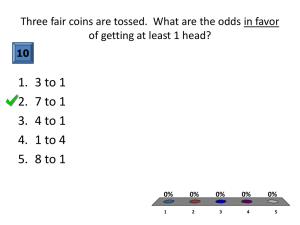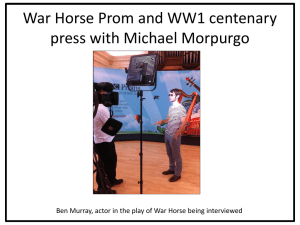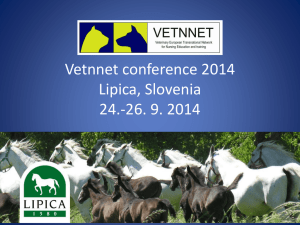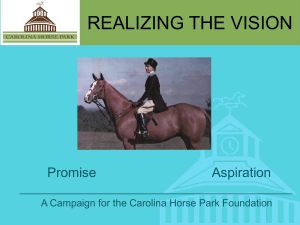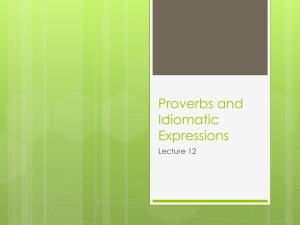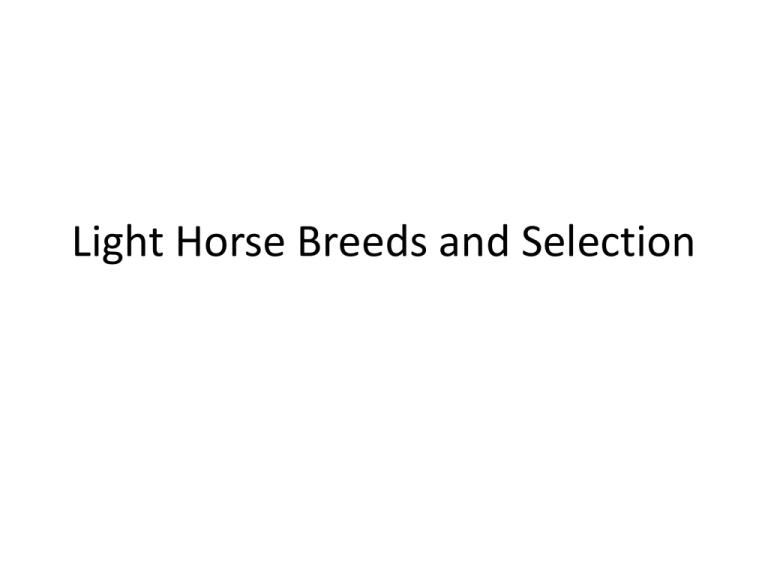
Light Horse Breeds and Selection
Terms and Definitions Associated With Light Horse
Breeds and Selection
• A. Aged horse. A horse over eight years old; often
used to refer to a horse over twelve years old.
• B. Band. A group of brood mares turned loose
together.
• C. Barefoot. Unshod.
• D. Bloodlines. The ancestry of an animal.
• E. Breed. Animals related by descent from
common ancestors and visibly similar in most
characteristics.
Terms and Definitions Associated With
Light Horse Breeds and Selection
• F. Breed association. An organization formed to keep
records of animals belonging to a particular breed; to issue
registration certificates (often called "papers") to such
animals; and to promote that particular breed.
• G. Broodmare. A mare used primarily for breeding
purposes.
• H. Castration. The removal of the testicles of a male horse.
• I. Colic. Pain originating from a digestive disturbance. It can
be caused by parasites, infectious diseases, excessive
consumption of feed or water, gas, impaction, etc. A horse
thrashing in severe pain from colic can twist a section of
the intestines and/or severely traumatize the head, neck
and legs. In some cases it is fatal.
Terms and Definitions Associated With
Light Horse Breeds and Selection
• J. Colt. A male horse under three years of age; an
uncastrated colt.
• K. Concentrates. Feed (such as grain) that contains a
high concentration of nutrients and very little bulk.
• L. Conformation. The composition and design of a
horse's body; twogheatth ietsr. made of (m.uscle,
bone, skin, blood, fat) and how its put
• M. Coupling. The part of the horse's body that joins the
forequarters to the hindquarters.
• N. Crossbred. The offspring of a sire and dam of
different breeds.
• O. Dam. The mother of an offspring.
Terms and Definitions Associated With
Light Horse Breeds and Selection
• P. Equine. Includes all members of the family
Equidae –horses, zebras, donkeys, etc.
• Q. Equine practitioner. A veterinarian that
specializes in treating horses.
• R. Farrier –Horse shoer.
• S. Far side -The right side of the horse.
• T. Filly -A female horse four years or younger that
has never produced a foal.
• U. Foal -A young nursing horse of either sex.
• V. Foaling -The process of a mare giving birth.
Terms and Definitions Associated With
Light Horse Breeds and Selection
• W. Founder -An inflammation of the sensitive
tissues within a horse's foot. It can be caused by
improper feeding, infection, working on too hard
of a surface, etc. Severe founder can render a
horse permanently disabled necessitating
euthanasia. Also called laminitis.
• X. Gait -The rhythmic characteristic movement of
a horse's feet and legs.
• Y. Geld -To castrate a male horse.
• Z. Gelding -A castrated male horse.
Terms and Definitions Associated With
Light Horse Breeds and Selection
• AA. Get (of sire) -The offspring of a stallion.
• BB. Grade -A horse that cannot be registered with any
breed association.
• CC. Hand -A unit of measure for determining the height
of a horse from the top of the withers to the bottom of
the front hoof (while the horse is standing straight on
level ground.) One hand equals four inches and
additional inches are shown to the right of a decimal
point. Example: 15.2 means 15 hands 2 inches.
• DD. Mare. A female horse over four or more years of
age or one that has produced a foal; a sexually mature
female horse.
Terms and Definitions Associated With
Light Horse Breeds and Selection
• EE. Near side -The left side of the horse.
• FF. Off side -The right side of the horse.
• GG.Purebred -A horse that comes from a long line
of horses of the same breed.
• HH. Registration -The recording of an animal in
the Stud Book of a particular breed association.
• II. Registry -An association that records the
ancestry of animals of a certain breed or origin.
• JJ. Roughage -The part of the diet that provides
more bulk than nourishment. Example: hay.
Terms and Definitions Associated With
Light Horse Breeds and Selection
• KK. Sire -The father of an offspring.
• LL. Stag -A stallion castrated late in life, retaining
stallion characteristics.
• MM. Stallion. A male horse four years of age or
older, sexually intact.
• NN. Stand at stud -A stallion that is available for
breeding.
• 00. Stud -1. A stallion kept for breeding purposes.
2. A farm that stands a stallion.
• PP. Stud colt -An uncastrated colt.
Terms and Definitions Associated With
Light Horse Breeds and Selection
• QQ. Type -That conformation that makes a
horse useful for a specific purpose.
• RR. Weanling -An animal that is less than one
year old that has been weaned from the mare.
• SS. Yearling -An animal that has passed its first
birthday but has not reached its second.
American Quarter Horse
• Origin – USA
• Color - Sorrel, chestnut, brown, black, bay,
gray, blue roan, red roan, grullo, dun, red dun,
buckskin, palomino
• Characteristics - Well-muscled; athletic; well
mannered; quiet disposition.
• Primary Use - Showing; pleasure; stock work;
short distance racing; games
American Quarter Horse
American Saddlebred Horse
• Origin - Kentucky
• Color - Bay, brown, chestnut, gray, roan, black,
or golden.
• Characteristics - Give an easy ride; long,
gracefully arched neck; naturally high head
carriage; long legs with sloping pasterns; high
stepping action
• Primary Use - Three- and five-gaited show and
pleasure horses; fine harness.
American Saddlebred Horse
Appaloosa
• Origin - Oregon, Washington, Idaho
• Color - All base colors with or without a
blanket and/or spots.
• Characteristics - The eyes have white scleras;
some will have vertical light and dark stripes
on the hooves; mottled or particolored skin.
• Primary Use - Showing; pleasure; stock work;
Arabian
• Origin - Arabia
• Color - Chestnut. bay, black, gray, roan.
• Characteristics - Dished face; short coupling;
naturally high tail carriage; great endurance.
• Primary Purpose - Showing; pleasure;
Appaloosa
Morgan
• Origin – New England, USA
• Color - Bay, brown, black, chestnut
• Characteristics - A substantial build; natural
gracefully arched neck; docile; endurance.
• Primary Use - Showing; pleasure; stock work;
driving
Morgan
National Spotted Saddle Horse
• Origin - Tennessee
• Color - A spotted color (white with a dark
color) above the hock and other than facial
markings.
• Characteristics - Must exhibit a gait other than
the trot. A stepping pace, rack, or any type of
saddle gait other than a trot will be
acceptable; shown in western tack.
• Primary Use - Showing; pleasure.
National Spotted Saddle Horse
Paint
• Origin – USA
• Color - White and any other color. There are
two patterns –tobiano and overo.
• Characteristics - Only those horses with
bloodlines that trace from a registered Paint
Horse, Quarter Horse, or Thoroughbred are
referred to as "Paints”
• Primary Use - Showing; pleasure; stock work;
racing.
Paint
Pinto
• Origin - U.S.A.
• Color - White and any other color. There are two
patterns –tobiano and overo.
• Characteristics - Can have blood lines that trace
from the following: Arabian, Morgan, Hackney,
American Saddlebred, Tennessee Walking Horse,
U.S. Trotter, some Half-Arabians, American
Shetland Pony, Welsh Pony, Connemara, Quarter
Horse, and Thoroughbred.
• Primary Use - Depending on the type: gaited
show horses; pleasure; stock work.
Pinto
Tennessee Walking Horse
• Origin – Tennessee
• Color - Sorrel, chestnut, black, roan, white,
bay, brown, gray, or golden
• Characteristics - The running walk gait.
• Primary Use - Showing; pleasure.
Tennessee Walking Horse
Thoroughbred
• Origin – England
• Color - Black, dark bay or brown, bay,
chestnut, gray, or roan.
• Characteristics - Long, straight, well muscled
legs with a sloping shoulder; long strided; long
neck.
• Primary Use – Showing (hunter/jumper);
pleasure; flat racing and steeplechase racing.
Thoroughbred
Three Major Divisions of Horses
• A. Light horses -Range in height from 14.2 to 17.2
hands, and in weight from 850 to 1300 pounds. They
are used for pleasure riding, showing, racing, driving
(pulling carts, wagons, etc.), and stock work.
• B. Ponies. Range in height from 9.0 to 14.2 hands, and
in weight from 300 to 850 pounds. They are used for
pleasure riding (primarily by children), showing, and
driving (pulling carts, wagons, etc.).
• C. Draft horses. Range in height from 15.2 to 17.2
hands, and in weight from 1500 to 2400 pounds. They
are used for heavy pulling (sleds, wagons, etc.)
Types of Horses and Their Uses
• A. Dressage. Trained to perform certain difficult
maneuvers, steps and gaits with minimal cues from the
rider.
• B. Endurance. Trained to compete against other horses
by running long distances.
• C. Games. Trained to compete in timed speed events
such as pole bending or barrel racing.
• D. Gaited. Trained to perform at the walk, trot, canter,
slowgait, and rack for pleasure and showing.
• E. Harness. Trained to pull vehicles used for pleasure or
showing.
Types of Horses and Their Uses
• F. Hunter. A well mannered collected horse that is trained to
jump fences that are on the average approximately three to
four feet high.
• G. Jumper. Trained to jump very high fences (in an obstacle
course of jumps), often times in the shortest amount of time
possible.
• H. Pleasure. Trained to be ridden with minimal effort from the
rider. This type of horse must be quiet, obedient, well
mannered, and have a way of going that is efficient and
comfortable for both the horse and rider.
• I. Racing. Trained to compete against other horses by running,
pacing, or trotting.
Types of Horses and Their Uses
• J. Saddle. Trained to perform various gaits
(depending on the breed; for example, the
Tennessee Walking Horse performs the running
walk gait), usually with a flashy high stepping
action and a proud head carriage. This type of
horse is used primarily for showing.
• K. Stock -A very muscular and athletic horse that
is trained to move at great speed for short
distances with sharp turns in order to perform
general ranch work, or show in reining, cutting, or
roping competitions.
Gates of Horses
• A. Walk -A slow, natural, flat footed, four beat gait. Each foot takes off
from and strikes the ground independently of the other three feet.
• B. Trot or Jog -A rapid diagonal two beat gait. The forefoot on one side and
the opposite hind foot take off and strike the ground at the same time.
• C. Canter or Lope -An easy rhythmical three beat gait. It is performed with
either a right or left "lead". The independent moving front leg is the
"lead". The canter starts with one hind foot striking the ground, then the
other hind foot and diagonal front foot strike the ground together
followed by the remaining front foot striking the ground.
• D. Gallop or Run -A very fast rhythmical four beat gait. The sequence of
hoof beats is very similar to the canter except that with the diagonal pairs
of legs, the rear diagonal foot strikes the ground slightly ahead of the front
diagonal foot. It is performed with either a right or left "lead".
Gates of Horses
•
•
•
•
E. Running Walk -The natural gait of the Tennessee Walking Horse. It is a diagonal
four beat gait. Each foot takes off and strikes the ground at separate intervals with
the front foot striking the ground before the diagonal hind foot. The hind quarters
propel the horse in motion. The hind feet over-reach the front feet from several to
over 36 inches producing a smooth gliding motion.
F. Stepping Pace or Slow Gait -A slow, lateral, four beat gait. Each foot strikes the
ground at separate intervals. The lateral hind and front feet start almost together I
but the hind foot strikes the ground ahead of the front foot on the same side. The
sequence of the beats is right hind, right front, left hind, and left front. This is the
fourth gait of the five-gaited show horses.
G. Rack -A fast, flashy, evenly timed, four beat gait. The feet start and stop at the
same intervals of time of each other. The sequence of beats is similar to the
sequence of the stepping pace, or slow gait. It is characterized by considerable
knee action and extreme speed. The front legs appear to trot and the hind legs
appear to be pacing. It is a very easy gait to ride, being very smooth. This is the
fifth gait of the five-gaited show horses.
H. Pace -A fast two beat lateral gait. The front and hind feet on the same side start
and stop at the same time. It is a speed gait that produces a rolling, side to side
motion.
Horse Coat Colors and Patterns
• A. Bay. Body color ranges from tan, through reddish brown, to
bright auburn. The mane and tail and lower portions of the legs will
always be black unless white markings are present. The tips and
outer edges of the ears are also often edged in black.
• B. Bay roan. The coat color is a product of the bay (red) hairs mixed
with white. The color of the mane, tail, and lower legs originates
from the bay pattern and will appear black.
• C. Black. Body color is black with no light areas. The muzzle, flanks
and legs must be black (with the exception of white markings) as
well as the mane and tail.
• D. Blanket. A term used to describe (in Appaloosas) a horse which
has a solid white area normally over, but not limited to, the hip area
with contrasting base color. (for example: white over hips.)
Horse Coat Colors and Patterns
• E. Blue roan. A more or less uniform mixture of white and black
hairs on the body, but usually darker on the head and lower legs;
can have a few red hairs in the mixture.
• F. Brown. The body color is brown or black with lighter colored
areas at the muzzle. Eyes, flank and inside upper legs; the legs,
mane, tail, and points (edges of the ears, etc.) are black.
• G. Buckskin. Body color yellowish or gold; the mane and tail are
black; the lower legs are usually black. Buckskins do not have
dorsal stripes.
• H. Chestnut. Body color dark red or brownish-red; the mane and
tail are usually dark red or brownish-red, but may be flaxen.
• I. Dappled. Light or dark spots over the basic body color.
Horse Coat Colors and Patterns
• J. Dun. Body color yellowish or gold; the mane and tail may be black,
brown or mixed; usually has a dorsal stripe, zebra stripes on the legs, and
a transverse stripe over the withers.
• K. Gray. The coat color is a mixture of white and dark hairs growing out of
dark skin. Foals are rarely born as a distinctly recognizable gray. They are
usually born chestnut or bay, and within weeks will begin showing signs of
gray around the eyes, flank, and below the elbow. Occasionally, gray
splotches will develop on the body, croup, or thigh before they are visible
around the eyes. During the graying process, a horse may show varying
shades of gray. Some may appear steel gray, a mixture of black and white
hairs. Others may be rose gray, a mixture of chestnut and white hairs, or a
bay gray, a mixture of bay and white hairs. Dappling is common. As gray
horses age, their coat colors lighten, sometimes appearing white.
Oftentimes, older gray horses grow tufts of reddish brown hair. This
coloring is called "flea-bitten". All of these combinations are considered to
be "gray".
Horse Coat Colors and Patterns
• L. Grulla or Grullo .The body color on this horse is often described as
smoky, dove, or mouse-colored and does not result from a mixture of dark
and white hairs. Rather, each hair will be mousecolored and the mane,
tail, and lower legs are usually black. They may also have a dorsal stripe, a
transverse shoulder stripe, and zebra stripes on the legs.
• M. Leopard. The body color is white with dark spots over a portion or all of
the body.
• N. Overo. One of the two major coat patterns exhibited by the Paint or
Pinto horse. It appears to be a colored horse with white markings. The
white usually will not cross the back of the horse between its withers and
tail. Generally, at least one, and often all four legs will be the dark color.
Head markings are often bald-faced, apron-faced, or bonnet-faced.
Generally, the white is irregular, rather scattered or splashy, and it is often
referred to as calico. The tail is usually one color. An overo horse may be
either predominantly dark or white.
Horse Coat Colors and Patterns
• O. Paint. The spectrum of colors range from almost total color with
minimal white markings to almost total white with minimal dark
markings. These darker colors range from very light to almost black
and encompass all of the hues known in the horse world.
• P. Palomino. The coat color is generally a golden yellow and the
mane and tail are always lighter than the body color, although
seldom pure white. Dapples sometimes appear across the rear of
the horse. The palomino has been described as being the color of
22 karat gold.
• Q. Pinto. A horse with this coloring must have noticeable white
markings on the body, not including the head and legs. A dark
cheek or cap, spotted face on a white horse, are common markings.
An all white horse with a colored area on the head and on the body
is acceptable, as well as a solid colored horse with a white spot on
the body.
Horse Coat Colors and Patterns
•
R. Red dun -A form of dun with body color yellowish or flesh
colored with the mane, tail and dorsal stripe being red in color. The
mane and tail may also be a flaxen color.
• S. Red or strawberry roan -A more or less uniform mixture of white
with red hairs on the body, but usually darker on the head and
lower legs. They can have a red, black or flaxen mane and/or tail.
• T. Roan -A coloring with about a fifty-fifty mixture of white and dark
hairs throughout the body. It may be difficult to tell the difference
between a rose gray and a roan at first. Roans show their
permanent coat color after shedding their foal coats. Unlike grays,
they do not dapple nor do they progressively lighten in color. Most
roans will have a dark head, while gray foals will first turn light on
the head.
• U. Sorrel -A body color that is reddish or copper-red. The mane and
tail are usually the same color as the body, but may be flaxen.
Horse Coat Colors and Patterns
• V. Spots -A term used to describe (in Appaloosas) a horse which has
white or dark spots over all or a portion of its body. (For example:
spots over loin and hips.)
• W. Tobiano -One of the two major coat patterns exhibited by the
Paint or Pinto horse. It appears to be a white horse with large spots
of color, often overlapping on animals with a greater percentage of
color than white. Head markings will be like those of a solid colored
horse -solid or with a blaze, strip, star or snip. Generally, all four
legs will be white, at least below the hocks and knees. Generally,
the spots are regular and distinct as ovals or round patterns that
extend down over the neck and chest, giving the appearance of a
shield. The horse usually will have the dark color on one or both
flanks. A tobiano may be either predominantly dark or white.
• X. " White -The body color is snow white with a pink or light colored
hide.
Face Markings
White marking between
eyes.
Comes in many shapes.
Thin line down
front of nose
Small white fleck
between nostrils
.
Thick white line down
front of nose. Horse also
has a star.
• Very
wide blaze that extends to and
may cover the eyes, nostrils, and upper
lip.
• Horses with bald faces often have
white that extends to the lower lip as
well.
Small white
marking up to
and including
the pastern.
Small white
marking on the
heel, at the
back of the hoof.
.
White marking
finishing around the
knee or hock.
White marking
that ends around
half-way up the
cannon bone.
Small white ring
around the coronet
band, above the
hoof.
Stocking that continues up the leg
Stocking that
continues up the
leg, but only
partially.
Eight Considerations That Apply to All
Breeds When Selecting A Horse
• A. Balance
– The design of the conformation; overall appearance of the horse; the
degree that all body parts are in proportion.
• B. Muscling.
– Quantity and quality. Example: Horses that are too narrow and too
shallow in muscling don't have a lot of stamina.
• C. Breed character.
– The horse must have the characteristics that are desired by the
industry for that particular breed.
• D. Sex character.
– Mares should look feminine, stallions should look masculine, and
geldings should not look like either.
Eight Considerations That Apply to All
Breeds When Selecting A Horse
• E. Structural correctness.
– Refers mainly to the proportions and dimensions of the skeletal
system.
• F. Movement –
– How straight a horse moves and the length and suppleness of the
strides; action.
• G. Quality or general appearance.
– Refers to refinement, condition of the hair coat, flat, clean bone, and
presence/charisma.
• H. Size.
– What is the desired size for that particular breed of horse.
Terms and Descriptions Pertaining to
Faulty Action
•
•
•
•
•
A. Cross firing -The inside of the back hoof hits the inside of the
diagonal front hoof.
B. Forging -The toe of the back hoof hits the bottom of the
lateral front hoof.
C. Interfering -At the walk or trot, the left fore hoof strikes the
right fore limb somewhere between the coronary band and the
knee. The right fore may interfere with the left fore. Generally,
interference marks are observed on the inside of the fetlock
joints. The same condition may also occur in the hind legs.
D. Over-reaching -Action wherein the toe of a hind foot strikes
the heel of a front foot. Wounds or scars on the fore heel are
usually caused by over-reaching.
E. Paddling -The fore foot swings outward in its flight forward.
Terms and Descriptions Pertaining to
Faulty Action
• F. Pointing -One leg extends out in front of the other while
the horse stands. The horse does this to keep weight off of
a sore foot and/or leg. It is seen most often in race horses.
• G. Rope walking or winding -The leg in motion swings
around and lands in front of the stationary leg.
• H. Scalping or speed cutting -The front hoof hits the lateral
hind hoof or leg. Hair on the hind leg is often removed in
this manner. It is seen most often in race horses.
• I. Traveling wide or spraddling out -At the walk or trot, the
distance between the hocks is far greater than the
imaginary lines of the hind legs.
• J. Winging -The fore foot swings inward (toward the
opposite leg) in its flight forward.
Conformation and Structural Defects Generally
Considered to be Hereditary in Nature
• A. Head
– 1. Parrot mouth (upper jaw over bites lower jaw).
– 2. Monkey mouth (lower jaw under bites upper
jaw).
– 3. Lop ears.
– 4. Small deep-set eyes (pig eyes).
– 5. Off color eyes (walled eyed)
Conformation and Structural Defects Generally
Considered to be Hereditary in Nature
• B. Body
–
–
–
–
–
–
–
–
–
–
–
1. Straight shoulder.
2. Lower withers (mutton withers).
3. Low back.
4. High croup.
5. Short croup.
6. Croup too sloping.
7. Short thick neck.
8. Ewe neck.
9. Hernias.
10. Wry tail (tail carried to the side).
11. Cryptorchid or monorchid (testicles not descended).
Conformation and Structural Defects Generally
Considered to be Hereditary in Nature
• C. Fore Limbs
– 1. Toes out (splay
footed).
– 2. Toes in (pigeon toed).
– 3. Knock-kneed.
– 4. Bow legs.
– 5. Base narrow.
– 6. Base wide.
– 7. Bench knees.
– 8. Pastern too short and
straight.
– 9. Weak pasterns.
– 10. Over in the knee
(buck knee).
– 11. Back in the knee
(calf knee).
– 12. Standing under.
– 13. Standing over.
– 14. Cut out under
knees.
– 15. Tied in at the knees.
Conformation and Structural Defects Generally
Considered to be Hereditary in Nature
• D. Hind Limbs
– 1. Sickle-hock.
– 2. Off the hocks
(hocks too far back).
– 3. Hocks too straight.
– 4. Base wide (standing
wide).
– 5. Bow legs and toes
in.
– 6. Base narrow
(standing close).
– 7. Cow hocked.
– 8. Weak pasterns.
– 9. Pastern too short
and straight.
– 10. Small feet.
– 11. Mule feet.
– 12. Contracted feet.
Terms and Definitions Associated With
Blemishes and Unsoundness
• A. Blindness or Defective Vision. The complete or partial loss of
sight in one or both eyes resulting from disease or injury. Some
cases of blindness are difficult to detect because the eye(s) appears
normal.
• B. Bowed Tendon. The flexor tendon on the cannon is enlarged
immediately below the knee and/or above the fetlock. The general
factors causing bowed tendons are severe strains to the tendon and
the tendon's sheath and/or actual tearing of the tendon fibers.
• C. Capped Elbow. As viewed from the side, the point of the elbow is
enlarged, usually caused by the horse lying on the hooves or shoes
on the front limbs.
• D. Capped Hock -As viewed from the side and rear, a firm
enlargement on the point of the hock. The enlargement is an
inflammation of the bursa. Trauma such as kicking a trailer gate or
kicking a stall wall are usual causes.
Terms and Definitions Associated With
Blemishes and Unsoundness
• E. Curb -As viewed from the side, a hard enlargement
on the rear (posterior) surface of the cannon
immediately below the point of the hock. Structural
defects (cow-hocks and sickle-hocks) stress the area
causing injury to the ligament.
• F. Enlarged Knee or Popped Knee. An enlargement of
the knee joint that may have been caused by chip
fractures, increased joint fluid and arthritic
modification.
• G. Fistula of the Withers -An inflammation on the
withers usually attributed to a bruise or irritation to
that area.
Terms and Definitions Associated With
Blemishes and Unsoundness
• H. laminitis or Founder -Initially, the condition involves
inflammation of the sensitive laminae in one or more hooves. The
inflammation is accompanied by circulatory congestion caused by
venous stagnation within the hoof. Severe pain results from the
circulatory congestion. The metabolic and physiological causes for
laminitis are not truly known in all cases; however, the mechanical
causes are quite variable -but labeled as:
– 1. Grain founder (ingestion of excessive quantities of grain).
– 2. Water founder (ingestion of large quantities of cold water by an
over-heated horse).
– 3. Grass founder (obese horses ingesting large amounts of legume hay
and/or lush pasture).
– 4. Road founder (concussion to hooves from work on hard surfaces).
– 5. Post parturient founder (retained placenta or uterine infection
resulting from foaling).
– A horse suffering from laminitis may have long heels, curved up toes
and concentric rings on the hoof surface.
Terms and Definitions Associated With
Blemishes and Unsoundness
• I. Navicular Disease. A calcification of the suspensory ligament of
the navicular bone which restricts the freedom of movement of the
pastern bone and joints. It is usually caused by concussion and
structural defect. (example: short, straight pasterns.)
• J. Pulmonary Emphysema (Heaves) .A chronic respiratory disease
which affects circulation, stamina and general condition. It is
characterized by heavy labored breathing.
• K. Quarter Crack, Toe Crack, Heel Crack. The cracks can occur on any
hoof and are identified according to location on the hoof. These
cracks are breaks in the continuity of the horny wall starting at the
bearing surface of the wall and migrating up the hoof or starting at
the coronet and migrating down the hoof. The crack may be
superficial or penetrate into the sensitive laminae. The cause for a
crack to start on the bearing surface is usually due to improper hoof
care. The crack originating at the coronary band is usually caused by
an injury.
Terms and Definitions Associated With
Blemishes and Unsoundness
• L. Ringbone. A bony ridge around the pastern bone
usually parallel to the coronary band caused by trauma
and usually resulting in lameness.
• M. Sidebones. Sidebones usually occur on the front
hooves as a result of concussion, injury or structural
defect (toe-in or toe-out). The lateral cartilages of the
coffin bone become calcified and restrict the action of
the hoof.
• P. Stifled -A dislocation of the stifle joint resulting in a
restriction of the joint and a dragging of the limb.
Terms and Definitions Associated With
Blemishes and Unsoundness
• N. Spavins.
– 1. Bog Spavin. Viewing the hock joint from the front, there will be a
distention of the joint capsule (an enlargement) on the inside front
portion of the joint. Three possible causes have been attributed to bog
spavins: structural defects (toe straight hind limb), trauma and rickets.
It is important to remember that no bone calcifications occurs -only
distention of joint fluid.
– 2. Bone Spavin (Jack or High Spavin) .Viewing the hock joint from the
front or rear -there will be a boney enlargement on the outside lower
portion of the joint. Structural defects (cow-hocks and sickle-hocks)
predispose the joint to bone spavin. The bony growth originates from
strain or over-exertion if the joint
– 3. Occult Spavin or Blind Spavin. Observation of the hock Joint
generally reveals nothing. Being difficult to diagnose, it is assumed
that blind spavins are caused by trauma. Calcification forms on the
adjacent bone surface in the hock, which prevents the normal
movement on the joint.
Terms and Definitions Associated With
Blemishes and Unsoundness
•
•
•
•
•
O. Splints -One or more enlargements on the inside (occasionally on the outside)
of the cannon-splint bone area usually on the fore legs. The enlargement(s) is
caused by calcification between the splint and cannon bones (splint area) due to
trauma.
Q. Sweeny -An atrophy of the shoulder muscles due to a paralysis of the
suprascapular nerve that is caused by strains or trauma.
R. Thoroughpins -As the hocks are viewed from the side and rear, an enlargement
is observed in the hollow area of the outside of the hock. Upon palpation, it is
noted that this enlargement is fluid filled and can be pushed from the outside of
the joint to the inside and back again. Strain on the flexor tendon caused an
escape of synovial (joint) fluid into the hollow area.
S. Umbilical Hernia -A protrusion of the intestines through the abdominal wall in
the area of the navel. Hernias of this type are commonly seen in young foals.
T. Windpuffs or Windgalls -A firm, fluid swelling occurring around a joint capsule,
tendon sheath or bursa. Windpuffs are commonly found on the knees, cannons
(tendon sheath) and fetlocks as a result of trauma(s).



